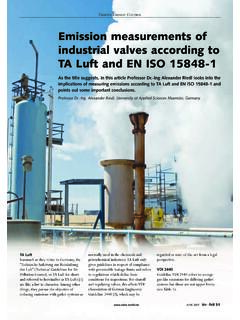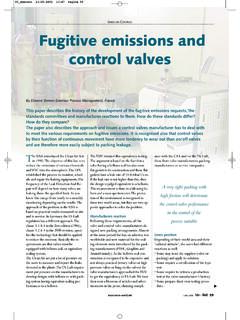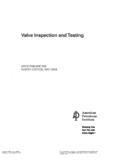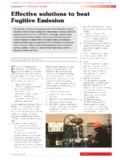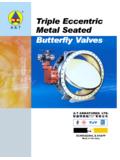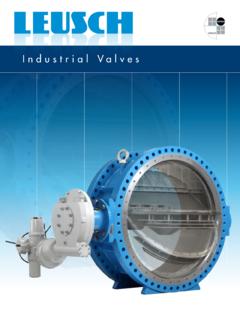Transcription of Valves in LNG service - Valve World
1 LNG1 January/February 2016 With LNG (Liquefi ed Natural Gas) becoming popular as a clean fuel there has been tremendous investment in LNG plants whilst additional signifi cant investments are expected in the future as well. In any process plant Valves are always at the heart of all operating and isolation philosophies, so when the discussion is about a highly fl ammable fl uid like LNG then it is no surprise that the Valves need and receive special Neeraj Batra (Piping Materials Engineer) and Hitoshi Suzuki (Technical Leader-Material Technology & Management group), Chiyoda CorporationValves in LNG serviceCommon terminologyA short discussion about terms related to cryogenic services will help the readers to have enhanced understanding about cryogenic Valves and especially Valves in LNG fluid: a gas that can be changed to a liquid by removal of heat by refrigeration methods to a temperature at -100 F (-73 C) or lower. Ethylene (boiling point -104 C at atmospheric pressure), methane (boiling point -162 C at atmospheric pressure) and nitrogen (boiling point -196 C at atmospheric pressure) are some common examples of cryogenic temperature: a temperature range of -100 F (-73 C) to -425 F (-254 C) is considered cryogenic in the Valve box: an enclosure that insulates a set of equipment from the environment without the need for insulation of the individual components inside the cold box.
2 A cold box is quite common in air separation box extension: a Valve body/bonnet extension section that removes the operating mechanism of the Valve outside the cold box and is required to be longer than a non-cold box extension. Although dictated by standards, this length is usually the distance between centerline of Valve and bottom of stuffing box/packing box extension: a body/bonnet extension that is used for Valves that are normally individually insulated. Although dictated by standards, this length is usually the distance between top of body bonnet joint and bottom of stuffing box/packing chamber. In this article, the focus will be on individually insulated Valves so all references to the bonnet extension will imply a non-cold box Valve lifted out of the cryogenic test bench for fugitive emission testing (leakage to atmosphere). Photo courtesy: Neway 2016 Drip plate: a circular plate welded to the bonnet extension to protect the insulation from column: that portion of the body/bonnet extension that allows for the formation of an insulating column of vapour.
3 This distance is not defined by any standards and is generally the vendor s recommendation (drip plate location on the bonnet).LNG: the abbreviation for liquefied natural gas, which is mainly methane (90-95%) with small amounts of ethane, propane, butane and nitrogen. Natural gas is converted into a liquid at cryogenic temperature (below -162 C) to reduce its volume (LNG in its liquid form occupies 1/600th of the volume of the equivalent amount of gas). Reduced volumes facilitate transport by LNG tankers from remote operating plants to the actual usage location where gas is not otherwise readily available. Qatar, Indonesia, Malaysia, Australia are some of the biggest LNG producers while Japan, Korea, India and China are the major consumers of design requirement for cryogenic valvesThe following features differentiate cryogenic Valves (especially Valves in LNG service ) from standard commodity extension: this is required to isolate the Valve packing from cold cryogenic temperatures since a frozen packing will render the Valve inoperable.
4 Also, Ice ball formed on the Valve s hand wheel/gearbox will also restrict the Valve usage by operator. The vapourized LNG in the bonnet extension acts as an insulation for length of bonnet extension is defined in standards like BS 6364 ( Valves for cryogenic service ), MSS SP-134 ( Valves for cryogenic service , including requirements for body/bonnet extension), and ISO 28921-1 (Industrial Valves -isolating Valves for low-temperature applications).For sizes not covered in these standards, vendors use FEM analysis to verify the temperature profile across the bonnet and packing area (see Fig. 1).Finally the vendor s recommended bonnet extension and gas column length are verified during the cryogenic testing of the installation: the recommended Valve installation is limited to a maximum of 45 degrees from the vertical position when handling LNG, in order to prevent cryogenic liquid entering the Valve packing area (see Fig. 2).Fig. 1: FEM simulation for testing effectiveness of the bonnet extension and gas column.
5 Photo courtesy: AEV Valves 4: Lip Seals. Photo courtesy Neway 2: Reference: ISO 28921 Industrial Valves -isolating Valves for low temperature applications, showing the recommended bonnet orientation for non-cold box installation. 45 45 Cavity relief mechanism: required for Valves with a cavity (floating and trunnion mounted ball Valves as well as wedge, slab and expanding gate Valves ). This feature prevents any fluid trapped inside the Valve from causing an excessive pressure in the event that surrounding heat causes it to gasify. (LNG will expand 600 times at ambient temperature. See Fig. 3)*The following methods are used for achieving self-cavity relief in Valve :Floating ball and wedge gate:-a hole is drilled in the ball/wedge which will balance the pressure in the cavity with the high pressure side during isolation of the ball Valve :-a combination of SPE (single piston effect) and DPE (double piston effect) seats are used. SPE is used Fig.
6 3: Ball Valve with cavity where LNG could be trapped. A = cavity (gap between ball and body); B = body shell; C = relieve the pressure on the high pressure side during the Isolation activity. SPE and DPE seat mechanisms are basically differentiated by the seat construction and the arrangement of the lip seals (see Fig. 4) in the grooves of the seat. LNG3 January/February 2016 The seat designs are such that cavity pressure will either push the seats away from the ball (SPE seats) or push the seats towards the ball (DPE seats).The cavity relief mechanism for slab gate and expanding gate Valve will not be discussed here since these Valves are not common in LNG service .*Additional considerations for Valves equipped with cavity relief mechanism:1. The direction of cavity relief shall be clearly indicated on the P&ID & the Valve (see Fig. 5). One good location for indication of direction is on the drip plate. Finally the Valve installation on site shall be according to this direction.
7 : When item to be isolated is located upstream of MBV: When item to be isolated is located downstream of MBVV enting direction shall be indicated as follows:2. Drilling a hole on the closing member or providing SPE seat on the Valve will render the Valve uni-directional. So, maintenance shall not be carried out on the cavity relief side. Some Valve manufacturers can argue that SPEXDPE seated ball Valves are bi-directional if the cavity is properly drained off prior to maintenance activities. However, in practice it can be very difficult to drain off the Valve cavity completely due to access problems to the bleed Valve (which will be under the insulation if provided).3. The diameter of the drilled hole shall be specified by Valve specification engineer. Normally a 3mm size is recommended although larger sizes may be seen on floating ball and gate SPEXDPE seats are not covered by any standard. So, if you have relied on SPE seats for cavity relief, then the working shall be checked during cavity relief test and supporting documents shall be available from the vendor describing how this mechanism was selection for cryogenic conditions: the most common material for cryogenic service Valve is austenitic stainless steel (SS 316).
8 Although SS 304 is the preferred material for pipes and fittings in LNG service for onshore plants, Fig. 5: Typical indication of the cavity relief direction of Valves in P&IDs (*MBV-Manual block Valve ) (Arrangement shown for a gate and ball Valve ).Fig. 6: PCTFE Seats. Photo courtesy Neway Orton BWT triple offset metal seated Valve after tight shut-off cryogenic pressure test (side top entry design).SS 316 is used for the Valves due to the better behaviour of the Valve function and trims at subzero temperatures. Although LNG is very clean, gate and globe Valves are generally specified half Stellite since LNG is very dry and hence a soft material is required in the ball Valves then PCTFE (Polychlorotrifluoroethylene) is used as seat insert (see Fig. 6) and PTFE (Polytetrafluoroethylene) and SS 316/Inconel is used for the sealing material (commonly called lip seals).O-rings made of elastomeric materials are not used in cryogenic Valves due to their low temperature usage restraints (generally limited to -40 C).
9 One important consideration for triple offset butterfly Valves is the selection of seat ring which is basically responsible for providing tight shut-off between the body seats and disc. To obtain optimized sealing performance, it is good engineering practice and indeed recommended by most leading Valve vendors to select solid seal ring in SS 316 austenitic stainless steel. This material grants long-term sealing capabilities in cryogenic connections: such as drains and vents shall not be provided on the Valves unless they are accessible. Normally Valves in LNG service are insulated with LNG4 January/February 2016thicknesses of 100-250 mm and hence these connections are not drain/vent connections are required for testing purpose, then the connections shall be seal welded with an impact-test qualified WPS. It is important to note that although impact testing is not required on base metal for temperatures up to -255 C per Table-A1M of ASME , the welds are required to be impact tested if the temperature is below -29 C since the filler metals are intentionally added with delta ferrite to avoid solidification cracking/hot cracking problem in selection: historically, flanged Valves have been used in LNG service .
10 However, increasing safety requirements and the efforts to minimize fugitive emissions and cryogenic spillage have dictated the use of butt-welded Valves in most of the LNG plants under construction.*Additional considerations for BW Valves in LNG service :1. Maintenance aspects shall be considered. Top entry ball Valve and butterfly Valves shall be selected. Provisions for temporary scaffolding space shall be considered in material handling. Handling of big sized balls, gate Valve wedges and butterfly Valve discs shall be If Valves are manufactured from castings, then the end connection of the Valves shall be radiographic tested since small casting defects on the butt-welded ends can aggravate during the welding For top entry butterfly Valves , the type of top entry (true top entry or side top entry) and its maintenance aspects shall be discussed with the of Valves : this topic is too broad to be covered in this article and needs separate attention.
